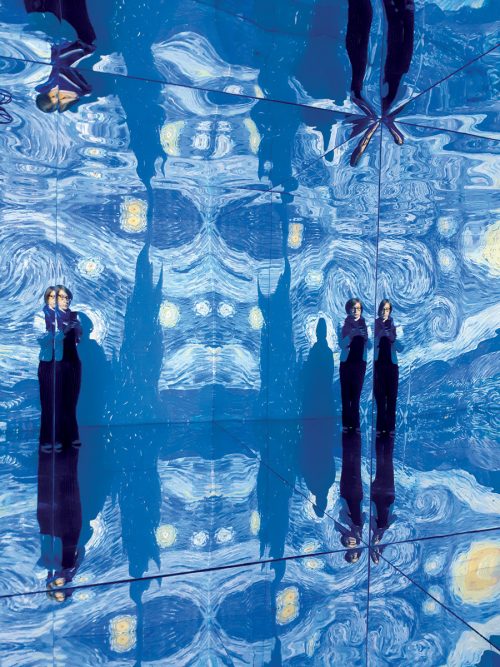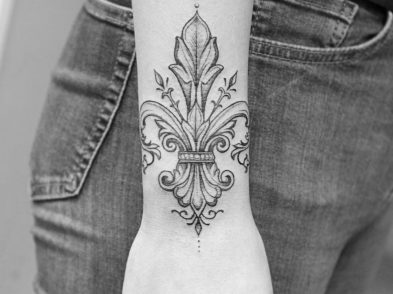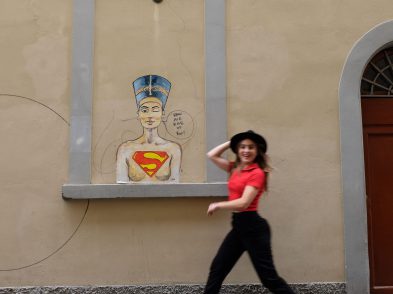Some say the permanent exhibition is dead. A static display unchanged over the centuries, save for the occasional rotating piece, may appear unattractive in comparison to the ever-evolving exhibits and high turnover of innovative concepts offered by the temporary. While the Uffizi’s high-season lines may cast doubts on such a conviction, there’s something happening a short distance away that makes you think there’s something to this claim after all.
In recent years, the deconsecrated church of Santo Stefano al Ponte has hosted a series of immersive exhibitions, or rather experiences, managed by the production company Crossmedia. These shows furnish an entirely new way of looking at our favourite artists and their works, complete with video projections, music and, at times, virtual reality. The rise of such experiences is hardly a surprise with technological advancements providing the opportunity to dive into artworks and their history. Plus, they are proving popular too.

The author at Van Gogh e i Maledetti
When Rain Room, an immersive exhibition featuring pouring rain that ceases when the sensors detect movement and leaves visitors dry as they wander through the space, opened at the MoMA in 2013, visitors flocked to see it, sometimes waiting up to five hours. What could make someone be willing to wait for that long? Call it a combination of “Everyone’s doing it” and genuine wow factor. A room where it rains, yet you immerge bone dry, is certainly an exhibit worth experiencing.
The shows at Santo Stefano al Ponte operate in the same vein, providing immersive settings for visitors to explore some of the world’s most famous artworks. Tommaso Mattei, director of communication and marketing at Crossmedia, explained what sparked the company’s foray into the realm of immersive experiences: “When Van Gogh Alive, produced by Grande Exhibitions, came to Italy in 2015, we managed its distribution and we thought, ‘Wait a minute. Art is in Italy. Leonardo, Donatello, the Renaissance. If they’re doing these things, why can’t we, here in the country, do the same thing?’ And so, we gave it a try, starting with Incredible Florence.”
Since then the company has gone on to produce six shows in Florence and other Italian cities. Artistic direction for Van Gogh e i Maledetti (Van Gogh and the Damned in English), currently running at Santo Stefano until March 31, was entrusted to Stefano Fomasi (known as Stefano Fake) of The Fake Factory, whose longtime work with video mapping and video art merged with immersive experiences when he went from making set designs for theatre performances to crafting works in which the public played the central character. “The motto I use, ‘Immerse yourself in art,’ means that you are the protagonist within the scenery as it changes. Bringing what I did for my work in theatre, dance and performances in general to a setting that was influenced by the public was a turning point for me in terms of interpreting this kind of art.”
One of the key characteristics of these experiences is their shareability, which is becoming a central focus during the design process. With over 55,000 hits for #rainroom at publication of this article, it’s easy to understand what it was that has peaked people’s interests in the years since the exhibition debuted. Could this be that, by nature, we yearn to be surrounded by beauty, wholly immersed in these otherworldly spaces? Many experiences these days are dedicated precisely to this concept. Take the now-closed Dream Machine, a visually shareable pop-up in Brooklyn created with Instagram in mind. Its neon-coloured rooms are a hipster millennial’s fantasy, with a ball pit, a Yayoi Kusama-style Infinity Room and a laundromat where visitors are given free cotton candy styled as “dryer lint”.
In spaces like these, content is second to the potential for a good photo op. But does a good photo op take away from experiences with a storytelling mission? Not necessarily. Talking about one of Crossmedia’s rising trends, Mattei conceded that the two facets are inherently intertwined. “We introduced the famous Mirror Room for the beauty of its content, but also with an eye towards social media…A room made entirely of mirrors where images of the artworks are projected onto the walls, floor, ceiling and your body. You go in there and you’re going to take a selfie.” The proof? Mattei says with pride that a Milan-based newspaper dubbed Inside Magritte the most “Instagrammable” exhibition ever done.
This doesn’t mean that an educational goal can’t be achieved. When asked what immersive experiences can offer compared to seeing the real artworks in person, both Mattei and Fomasi agreed that they provide visual, emotional and intellectual stimulation. At a time when children and adults live on their smartphones, it can no longer be assumed that a simple label under Leonardo’s Annunciation is enough to stimulate the minds of the visually oriented, but video projections and mirror rooms could certainly do the trick. As Fomasi explained, “When you go to see a thing like {these experiences}, it’s to be fascinated by art, not simply stand around looking at paintings. If that’s what you wanted, you’d just look at a slideshow {…} What art critics don’t understand is that when they talk about immersive experiences, they think we just project paintings onto the walls. But that’s not what this is.”
Mattei, too, thinks that immersive experiences can offer much more than just a good Instagram photo. “In addition to offering an element of emotion—because it can be very emotional to be immersed in these large, beautiful spaces that make you feel part of the artwork, inside the lives of these artists—the other goal we hope to achieve is to be a door through which to approach real art. If we have a visitor who comes to see Klimt Experience, I hope that they are inspired to go to Vienna to see The Kiss in person.”








